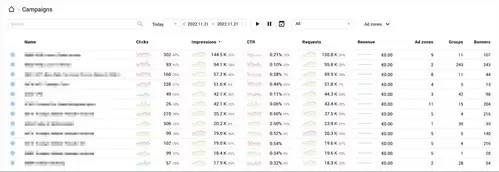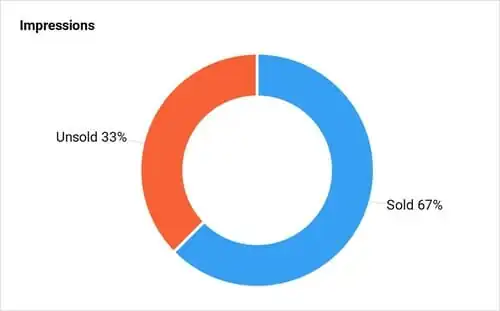According to Statista, a popular research service, in 2019, around 25.8% of internet users blocked online ads on their devices using ad blockers. This practice continued in 2019, meaning a quarter of paid ads never reached their audiences.
Bypassing ad blockers can help ensure that a website can continue to generate revenue. Even through advertising and support its operations. This article will help you sort out the problem of ad blocking. So that you`d have a positive impact on website revenue.
What Are Ad Blockers?
Ad blockers are software programs. You can install them on a device or browser to prevent advertisements from appearing on a webpage. They can either block or remove advertisements from being displayed on websites. An ad blocker identifies and removes the snippet of code responsible for displaying ads on a webpage. These software programs can also block requests to external ad servers. It removes the advertisement from the host website.
Some popular ad blockers are:
- Adblock Plus
- uBlock Origin
- Poper Blocker
- Ghostery
- AdGuard
- AdBlock
- AdLock
- Privacy Badger.
How Do Ad Blockers Work?
Ad-blocking programs prevent advertising, deactivate trackers, and are utilized as built-in or browser add-ons to block online ads. Here are the different techniques that ad blockers use to remove advertisement scripts:
- Blacklists: Ad blockers maintain a list of known ad-serving domains blocked by default. When a user visits a website, the ad blocker checks the website’s code against its blacklist to see if any ad-serving domains are present. If any are found, the ads are blocked from being displayed.
- Filtering: Ad blockers use a set of filtering rules to identify and remove specific webpage elements that they associate with ads. These rules can target specific HTML tags, CSS classes, or JavaScript code commonly used to display ads.
- Script blocking: Ad blockers can block scripts, such as JavaScript, that display ad or track user data. This prevents the ads from being displayed and stops the website from collecting data about user browsing habits.
- Whitelists: Some ad blockers allow users to add specific websites to a whitelist. This means that the ad blocker will not block ads on those websites.
- Ad-blocking browser extensions: Some ad-blockers are browser extensions that can be installed in browsers to block ads. They work by intercepting requests made by the browser to external ad servers and preventing them from returning ads.
Why Ad Blockers Are Bad for Website Revenue?
Ad blockers are nasty for website revenue because they prevent ads from being displayed. This can negatively impact a website’s ability to generate revenue through advertising. Many websites rely on advertising as a primary source of income. Thus, using ad blockers can significantly reduce the number of ads displayed to users. This in turn can reduce the amount of revenue a website can generate. Ad-blockers can also prevent users from seeing important ads for their experience. For instance, promotional offers or essential information.
Some websites also rely on ads to support the cost of providing free content to users. And the use of ad blockers can make it easier for these websites to continue providing this content without charging users.
Additionally, some website owners may use ads. They do it to provide users with an improved experience, such as by providing relevant ads that are tailored to the user’s interests. Ad-blockers can prevent this and may even block important website features. For example, the ability to purchase products or access certain content, which can negatively impact the user experience.
Overall, ad blockers can negatively impact a website’s ability to generate revenue, making it difficult to continue operating and providing content to users.
Top 6 Tactics for Bypassing Ad Blockers
Here are the top tactics for a publisher to bypass ad blockers.
Use Native Advertising
Native advertising spending is to reach $400 bn by 2025. These ads feel and function as a natural part of your website content. So one can target it to specific demographics or interests, increasing their effectiveness. Native ads can evade ad blockers as they blend with the publisher’s content. Besides, they also offer valuable information and enjoyable content for the viewers to develop engagement and trust for your website. The more inspiring the content, the less the reader will likely get annoyed.
Some ad blockers, such as Adblock, offer a choice to visitors whether they want to block native ads or not.
Use Advertising Engines That Bypass Ad Blockers
Some advertising engines like Finteza can avoid ad blockers as all data between users. And they proxy the service via their own website. Hence, browsers cannot block the data, and their plugins and publishers can enjoy more profits. The system provides detailed statistics on impressions and clicks.
It also lets you view your inventory for each advertising zone so that you remain aware of the percentage of the ads sold.
Finteza offers support for modern formats like GIF, PNG, JPG, and HTML5, as well as adaptive banners. Due to the efficient bypassing of ad blockers, Finteza helps to increase your publisher revenue by providing additional impressions and clicks.
Use Acceptable Ads
“Acceptable ads” is a certain concept. Some ad blockers use it to allow certain ads to be displayed on websites. Even when ad-blocking software is enabled. These ads are pretty”acceptable”. This is because they are less intrusive and more respectful of the user’s experience. For example, they may be smaller in size, less obtrusive in their placement on the page, or less disruptive in their animation or sound. You can apply as a publisher to have your ads included on this list.
Use CAPTCHA
CAPTCHA stands for Completely Automated Public Turing test to tell Computers and Humans Apart. It is a type of challenge-response test to determine whether or not the user is a human. You can use CAPTCHA or other verification forms to ensure that the user is a human and not an ad blocker. Some of the most common types of CAPTCHA include:
- Text-based CAPTCHA: This type of CAPTCHA displays distorted or obscured text. The one that the user must enter correctly in order to prove that they are human.
- Image-based CAPTCHA: This type of CAPTCHA displays images. For instance, street signs or animals, and the user must select the correct image or images to prove that they are human.
- Audio CAPTCHA: They designed this type of CAPTCHA for visually impaired users. It provides an audio version of the test that the user can listen to and enter the correct answer.
- ReCAPTCHA: This type of CAPTCHA developed by Google uses advanced risk analysis techniques to tell humans and bots apart. It presents a user with a set of challenges such as ticking the box “I’m not a robot,” or solving a puzzle, or identifying traffic lights in a set of images.
- hCAPTCHA: A new type of CAPTCHA that uses a simple checkbox and JavaScript to create the challenge. They designed it to be more user-friendly than traditional CAPTCHA, but still effective in blocking bots.
CAPTCHA can be an effective way to block bots from accessing a website.
Use Browser-Specific Code for Bypassing Ad Blockers
In the context of ad blocking, some ad blockers only work on specific browsers. And websites can use browser-specific code to bypass these ad blockers. For example, a website might serve different ads to users depending on the browser they are using. With ads that ad blockers block on one browser being served to users on a different browser.
Using a Mix of Ad Formats
Some ad blockers only block certain ads, such as pop-ups or banners. Websites can use different ad formats not blocked by the ad blocker.
Some examples of ad formats that are less likely to be blocked by ad blockers include:
- Native ads: These ads are designed to blend in with the content of the website or app they appear on, making them less intrusive and more likely to be viewed by users.
- Text-based ads: These are usually simple text links that are less likely to be blocked because they do not use images or other multimedia. In-feed ads: These ads appear in the content feed of a website or app, making them less disruptive and more likely to be seen by users.
- In-article ads: These ads are placed within the content of an article, making them less disruptive and more likely to be seen by users.
- Sponsored content: These ads are content that is created or sponsored by an advertiser but is presented in such a way that it looks like editorial content.
It’s important to note that as ad-blockers constantly update their rules and techniques. What they don`t block today, they may block it tomorrow. Advertisers and publishers should be aware of this and strive to create ads that are relevant, non-intrusive, and respectful of the user’s experience to reduce the incentive for users to install ad blockers.
Conclusion
- Bypassing ad blockers is essential for websites and companies that rely on advertising revenue to survive.
- Without the ability to show ads, these websites would not be able to generate the revenue they need to cover their costs, such as hosting and development expenses, and may have to close down.
- Websites and companies should strive to create ads that are relevant, non-intrusive, and respectful of the user’s experience in order to reduce the incentive for users to install ad blockers in the first place.

Petr is a serial tech entrepreneur and the CEO of Apro Software, a machine learning company. Whenever he’s not blogging about technology for itechgyan.com or softwarebattle.com, Petr enjoys playing sports and going to the movies. He’s also deeply interested in mediation, Buddhism and biohacking.



